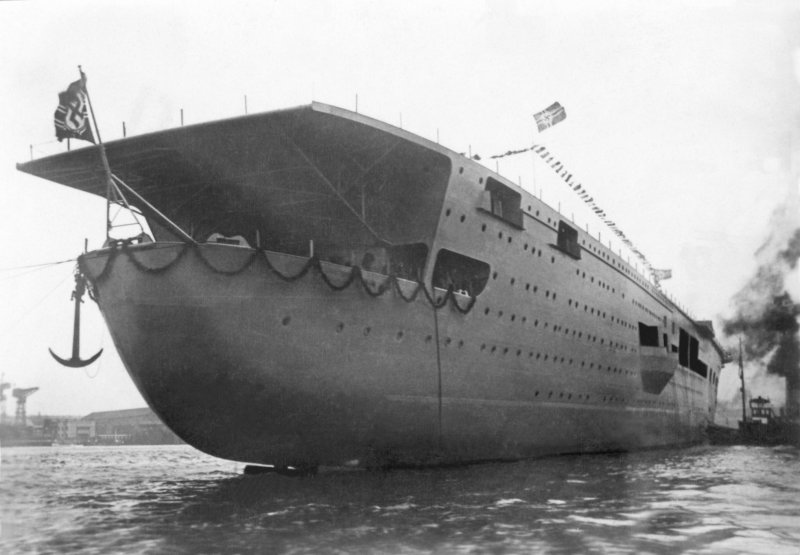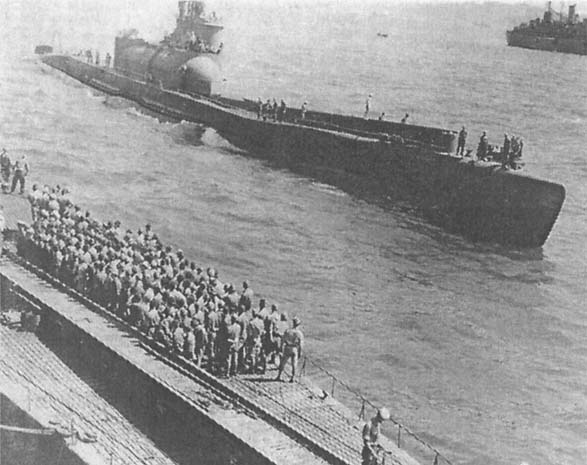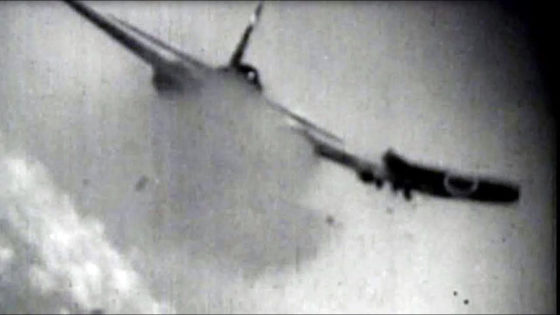
“By 1940, the carrier, now christened the Graf Zeppelin, was still not yet ready for service — a shortage of anti-aircraft guns kept her in the shipyards.”
EVEN BEFORE THE OUTBREAK of the Second World War, aircraft carriers had redefined how conflicts would be fought at sea. Prior to the rise of the flat top, the battleship was king. Air power changed all that. Between 1939 and 1945, carriers with names like Hornet, Lexington, Enterprise, Akagi, Kaga, Hiryu, Soryu, Illustrious, and Ark Royal would make decisive contributions to the very outcome of the war. Yet, posterity never got the chance to record the exploits of a handful lesser-known yet equally extraordinary aircraft carriers. And in many ways, these forgotten vessels are just as fascinating. Let’s meet a few of them:

The Graf Zeppelin
Although the German navy of World War Two is best known for its U-boats and its battleships Tirpitz and Bismarck, the Kriegsmarine did put one aircraft carrier into the water — the Graf Zeppelin — and was planning on building another.
The 33,000-ton vessel, originally designated simply as Flugzeugträger A, was laid down in December 1936. Although incomplete, she was launched two years later.[1]
When war broke out in 1939, the still-unfinished carrier remained in Kiel with its newly formed Luftwaffe carrier wing Trägergrüppe 186. The air group consisted of three squadrons of Messerschmitt Bf-109s and Junkers Ju-87 Stukas. [2]
By 1940, the carrier, now christened the Graf Zeppelin, was still not yet ready for service — a shortage of anti-aircraft guns kept her in the shipyards. With Kiel in range of British bombers, the enormous vessel was towed to Gotenhafen in the summer of 1940, where she would continue to sit idle for two more years.
By 1942, German naval planners, Admiral Raeder in particular, were seeing the enormous contributions being made by aircraft carriers in the Atlantic, the Mediterranean and even the Pacific. The naval chief coaxed Hitler to approve the resumption of work on the Zeppelin. [3] But by that point, Germany’s resources were stretched to the limit and the Kriegsmarine would be hard-pressed to provide both improved aircraft for the ship as well as pilots trained in carrier operations. Worse, the necessary anti-aircraft guns needed to defend the ship were still too scarce. Despite this, the navy aimed for completion date sometime in the summer of 1943, to be followed by up to six months of sea trials.
As the work continued, the RAF organized a squadron of Lancasters to strike at the Zeppelin. While British records of the August 1942 raid show the target was hit by at least one RAF 5,500 lb. bomb, there is no mention by the Germans of any damage inflicted on the ship in the raid.
By early 1943, Hitler became fed up with Reader’s handling of the war at sea and replaced him with the commander of U-boat operations, Karl Donitz. The new head of the Kriegsmarine ordered the Zeppelin mothballed and diverted all energy into the production of new and improved submarines. The Zeppelin sat as an idle hulk in Stettin, Poland for the remainder of the war.
Still in the harbor in April 1945, the Zeppelin was scuttled by a skeleton crew as the Red Army entered the city, although the water was so shallow, the flight deck remained above the waterline. After the war, the Soviets refloated the ship, repaired it and completed her, after which point she was pressed into the Soviet Baltic Fleet. [4] In fact, the Zeppelin (the Soviets kept the original name) was the Soviet’s first aircraft carrier – Russia wouldn’t build its own until 1967. Rather than operating it in its intended role, the Red fleet renamed the Zeppelin “Floating Base 101” and in 1947 used her for target practice. In 2006, an exploration vessel with a Polish oil company located the hull off the port city of Leba at a depth of nearly 300 feet. Too far down to be reached by recreational divers, the Zeppelin remains undisturbed to this day.[5]

Japan’s Carrier Submarine
Unlike the Zeppelin, the Japan’s I-400 series vessels did see active service in the Second World War. Interestingly enough however, these ships weren’t conventional aircraft carriers at all. They were a hybrid: part submarine, part carrier.
Conceived by the commander of the Japanese navy, Admiral Isoroku Yamamoto, the I-400 series went into production between 1942 and 1945. Only three out of 18 ordered were built. The I-400, which at 6,500 tons was by far the largest sub of the war, carried three foldable-winged Aichi M6A bombers within a 100-foot-long watertight, forward-opening hangar. The aircraft could be launched from a compressed air driven catapult and runway built into the forward deck. Equipped with pontoons, all three planes could be loosed in as little as 15 minutes and could land in the water, whereby they were brought back on board by a large retractable crane located near the front of the 400 foot long sub. Even without the aircraft, the I-400 packed a potent punch. It carried eight forward-firing torpedo tubes, a 14 cm deck gun and a battery of 25 mm anti aircraft guns.
The sub, which had the range to travel anywhere in the world, was designed to approach the coast of the United States by stealth, surface, launch its aircraft, which would speed off to strike at coastal targets. The sub would then dive to avoid detection. The I-400 would loiter beneath the waves until the aircraft returned, at which point it would surface, recover the planes and move on.
In 1945, two I-400s, along with a pair of other subs modified to carry floatplanes, were tasked with destroying the heavily guarded Panama Canal, thus disrupting American shipping. [6] The vessels were expected to make their way to the coast of Ecuador and launch 10 aircraft that would fly north over Columbia into Panama and take out one of the canal’s locks, thereby bottling up the vital sea way that linked America’s Atlantic and Pacific fleets. However, by the time the mission was ready to launch, the war was nearly over. The Japanese admiralty realized that an attack on the canal would be a futile gesture at best and instead assigned two I-400s to strike at an American fleet gathering in the Caroline Islands that August.
The war ended before that raid could be launched however and Japan’s I-400s were surrendered to the Americans on VJ Day. The U.S. Navy gathered the three boats, along with 21 other captured submarines, and confined them a port near Nagasaki for study. When the Soviets announced their intentions to examine the prizes themselves, the Americans had most of the Japanese subs towed out to sea and scuttled. [7] It saved two of the carrier subs and transported them to Hawaii for additional examination. These were themselves sent to the bottom in 1946. It wasn’t until the 1960s that any navy built subs larger than the I-400s.

Project Habakkuk
In 1941, with German U-boats threatening to starve Great Britain into submission, the admiralty turned to an eccentric journalist and inventor named Geoffrey Pike to come up with a way to make ships impervious to torpedoes.
Pike, a civilian employee at the British Combined Operations Headquarters, came up with a novel idea: why not make ships out of ice, more specifically a much stronger substance called pykrete. [8] Pykrete, which is made out of a mixture of ice and wood pulp, is just as strong or stronger than steel but requires only 1 percent of the energy to produce. Better still, pykrete can take considerable damage without buckling and it melts much more slowly than ice, thanks to the insulating properties of the wood pulp. Best of all it can float. Pike’s scheme called for the construction of large flattop pykrete icebergs that could serve as enormous floating airfields – a sort of mobile island an airbase. The plan, presented to Churchill by Lord Mountbatten, was green-lighted for 1944 and dubbed Project Habakkuk.
A thousand-ton model ice ship was built in Alberta, Canada to test the feasibility of pykrete. Prime Minister Churchill hoped the Canadians would speed production of a 2,000-foot-long seaworthy pykrete carrier within the year. The enormous floating platform would be capable of launching and recovering not just fighters but entire wings of heavy bombers. With a 40-foot thick hull, the carrier would also be effectively torpedo-proof and largely indestructible. The ice carrier’s mission would be to steam into the middle of the North Atlantic and act as a floating airfield from which bombers could hunt German U-boats without respite. Estimates had the first vessel costing between £1 to 3 million. The finished product would be made of 300,000 tones of wood pulp, 35,000 tons of timber framing, 25,000 tons of fiberboard and 10,000 tones of steel. [8]
Eventually, production delays and a shortage of the vast amounts of materials required rendered the entire project less feasible than originally anticipated. [9] Despite being able to launch heavy bombers in mid-ocean, the vessel would require four onboard power stations and would need a refrigeration system of incalculable size just to function. Ultimately, world events would overtake the project: After the Normandy landings and Germany’s loss of its submarine bases on the Atlantic Ocean, the U-boat threat diminished considerably. That same year, Portugal granted the Allies permission to launch anti-submarine flights from its shores rendering the entire project largely needless. Habakkuk was shelved and quickly forgotten. [10] However, it would take three more summers for the original model to melt.
2. http://en.wikipedia.org/wiki/German_aircraft_carrier_Graf_Zeppelin
4. http://www.damninteresting.com/the-only-nazi-aircraft-carrier/
6. http://en.wikipedia.org/wiki/I-400
7. Ibid.
8. http://en.wikipedia.org/wiki/Project_Habakkuk
9. Ibid.
10. Ibid










Had the Graf Zeppelin been finished and operational early in the war, she would have made an interesting commerce raider, with a air group capable of spotting both potential targets and allied units that might have been hunting her. Considering the poor state of Royal Navy carrier aviation they would have had a hard time countering her.
True! It might have been a game-changer.
The one things I found amazing is that the carrier, which ended up being taken by the Russians, became the Soviet’s first aircraft carrier. They used it as a target hulk two years later — I wonder why they never kept the vessel though, retrofitted it and added it to their fleet.
Awesome. 🙂 Graf Zeppelin is my all time favorite aircraft carrier. :3 I knew the Germans had almost finished it (95 percent complete) but had no idea it was actually completed. Wonder why the Soviets never operated any aircraft from it. :/ I knew they wanted experience with sinking a carrier, but still a tad wasteful IMO, but to be fair, it probably would have met the same fate after it’s service with the Russians was over. Took one hell of a beating before sinking. Tough as nails that ship. One of the few examples of a carrier that could fight for itself without having to rely solely on it’s aircraft for protection. In that respect, it’s quite comparable with the HMS Illustrious carrier in design philosophy, which is almost universally regarded as one of the finest carriers of the war. Good design that mostly catches flak simply because it was built by “those evil Nazis.” ;P The Bismarck might well have survived if it had the Graf escorting it (along with the Kriegsmarine’s other heavy ships of course). Great article BTW. 10/10 🙂
The vessel was scuttled by the Germans and raised by the Russians. It is extremely difficult to put a scuttled ship into service, especially one which had never actually been IN service. The other major reason they never “put it into service” is the nascent level of Kriegsmarine naval-air technology and understanding. Taking one country’s fumblings toward naval air power and adding it to your own fumblings does not make for a good mix.
The story I heard was that is was loaded with booty from Soviet occupied Germany and sank while under tow back to the Soviet union. The Soviets never used it as an aircraft carrier and never developed aircraft for it.
The Germans produced some modified ME 109s for it and would have had Stukas as well. Later there were attempts to use FW-190s including some that could carry torpedoes.
Admiral ” Raeder”